July 2007 (Part 2)
SELECTION OF QUESTIONS AND ANSWERS
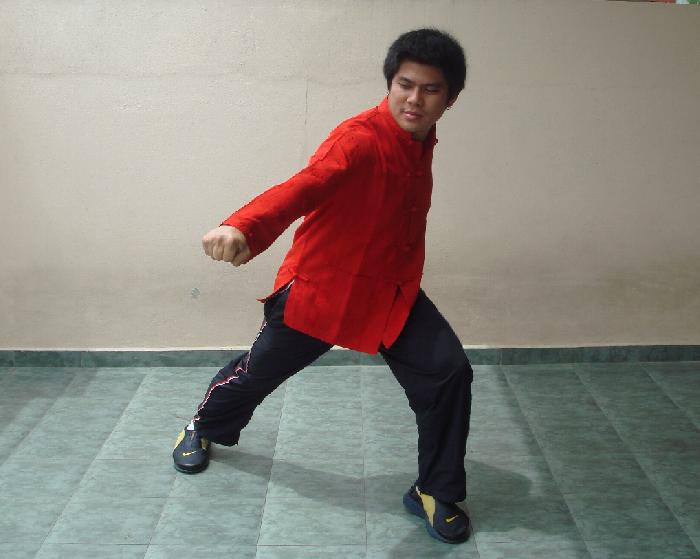
Sifu Wong Chun Nga demonstrating a pattern called “Slant Body Strike Tiger” from the Taming-Tiger Set
Question 1
I'm particularly very interested in the Hung Gar Tiet Sin Kuen (Iron Wire Fist) set and I really hope to one day get a chance to learn this fascinating set.
— Ron, Australia
Answer
You will find a lot of useful material on “Thit Seen Khuen”, or “Iron Wire Set”, and Hoong Ka Kungfu in the May 2007 Part 1, May 2007 Part 2 and May 2007 Part 3 of my Question-Answer Series.
As “Thit Seen Khuen” is an advanced set, it is highly advisable to learn it from a competent teacher. You should not learn it from just any teacher, because if his teaching is not correct, you can get a lot of harm. Unless you are already an accomplished kungfu practitioner, earning it from books or videos is also not recommended. It is easy to practice this set wrongly and therefore harm yourself.
A good way to tell whether a teacher is competent in teaching “Thit Seen Khuen” or any art is to see whether he and his students exhibit the results that his art is purported to give. As “Thit Seen Khuen” is purported to give radiant health and internal force, a teacher teaching it should be an example of these qualities.
“Thit Seen Khuen” is an advanced chi kung set, but is often wrongly practiced as an isometric exercise. A tell-tale difference is that in chi kung you have to relax, but in an isometric exercise you tense your muscles. A tell-tale result of practicing “Thit Seen Khuen” correctly is to have tremendous internal force, yet peaceful and graceful. A tell-tale result of practicing isometric exercise correctly is to have big muscles. Both types of exercise will make a practitioner very stong, but the nature of his strength is vastly different.
While having big muscles is admired in Western culture, from the traditional kungfu perspective it is not desirable. Big muscles draw away and lock up energy which could otherwise be used for life maintenance and performance.
A muscle-bound person is normally slow and easily out of breath. His internal organs, which already receive less energy, have to do more work due to the extra weight of the muscles. Worse, being muscle-bound may block energy flow, resulting in poor health, though he may be physically strong.
Both Sifu Thit Kiew Sam, the master best known for “Thit Seen Khuen”, and Sifu Lam Sai Weng, the master instrumental in transmitting “Thit Seen Khuen” to the modern world, were very powerful, yet gentle and elegant, not muscle-bound.
Question 2
Could you tell me about the philosophy, theories, principles, practice and possibly some applications of Tiet Sin Kuen.
Answer
In Chinese philosophy, every being is composed of “jing”, “qi” and “shen”, which are “essence”, “energy” and “spirit”. Your “essence” is the sub-atomic particles that make up your physical body. Your “qi” is the energy that maintains and carries on life. Your “shen” is the real you. It is called differently by different peoples as the spirit, soul, mind or consciousness.
To develop wholesomely, you must develop all these three components. If you have only a muscular body but lacking in vitality (like muscle-bound men becoming tired easily after some physical or mental work), or have vitality but lacking in mental clarity (like some people working very hard but without purpose or direction), or have a good spirit but lacking in vitality (like one with good intention but lacking the energy to carry out the necessary work), your development would be unbalanced.
The theory behind the training of “Thit Seen Khuen” (or Iron Wiure Set) as well as all other genuine chi kung (qigong), is that by developing all the three components of “jing”, “qi” and “shen”, a practitioner develops wholesomely. And this theory has been confirmed by centuries of practical experience. If he neglects any one of these dimensions, his development would be incomplete.
Sadly, many martial artists today do not understand this philosophy and theory. Hence, though they may be physically strong, they are not healthy as they often sustain a lot of injury. They are also easily tired, which shows they lack vitality. They are often stressful and aggressive, which indicates that they have done poorly in spiritual development. They would have prevented this unhealthy development if they had a sound understanding of chi kung philosophy and theory.
Two important principles in the practice of “Thit Seen Khuen” are “noi ngoi sheong sau” and “kong yau ping chai”, which are in Cantonese pronunciation meaning respectively “cultivate internally and externally”, and “hard and soft being integrated”. Internal and external cultivation means training not just the physical body but also energy and mind. Hard and soft being integrated means that a practitioner is both powerful and gentle at the same time. Appreciating these two principles can readily show that if one practices “Thit Seen Khuen” as an isometric exercise, he is practicing wrongly, as this involves only the external and the hard, neglecting the internal and the soft.
The practice of “Thit Seen Khuen” or any force training should be consistent and regular, i.e. everyday for a reasonable period of time. Depending on the standard aimed at, and the developmental level of the practitioner, six month to a year of daily practice would be a reasonable period of time to attain remarkable result. A good time to practice is early in the morning, or in the evening or at night. One should feel more energetic and fresh after each training session.
The application of “Thit Seen Khuen” should not just be limited to martial purposes. An important kungfu tenet is “first good health, then combat”. As “Thit Seen Khuen” gives us good health, enhances our vitality and nourishes our spirit, its successful practice enables us to perform better no matter what we do — in both our work and play, and in our personal and public life. If by practicing “Thit Seen Khuen” a practitioner develops a lot of internal force enabling him to be a formidable fighter, but he becomes negligent in his work, difficult with his family and friends, and hard on himself, he would have failed miserably.
In terms of martial application, the value of “Thit Seen Khuen” is holistic. It gives a practitioner not only tremendous internal force but also agility and mental clarity, thus enabling him to be a better fighter no matter what techniques he uses. The techniques or patterns in the “Thit Seen Khuen” set are meant to develop internal force, and not meant for attack and defence movements.
Nevertheless, a master may use these patterns for combat, albeit with some modification of the form. For example, I can apply the first pattern shown in the short selection of my performance of “Thit Seen Khuen” shown here to break an opponent's arm as he attempts to strike me. Or if he holds my two hands, I can use this pattern to break his wrist while releasing the hold. Or if he tries to take me down with a “shoot” as in wrestling, I can apply this pattern to stop him and break his neck or strike his temples. This pattern, known in Sifu Lam Sai Weng's classic as “Protecting the Dan Tian”, is known in our school as “Cross-Road Scissor-Hands”.
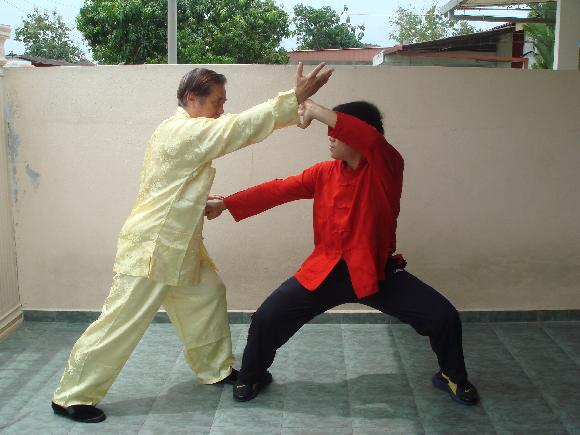
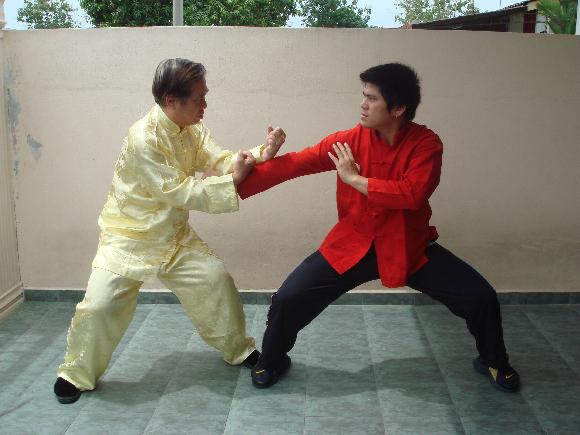
Sifu Wong Chun Nga floats Grandmaster Wong's chopping attack and counters with “White Horse Returns Head”. Without moving his feet, Grandmaster Wong sinks back his body and fractures Sifu Wong's attacking forearm with the pattern “Cross-Road Scissor-Hands”, which is known as “Guarding the Dan Tian” in the Iron-Wire Set.
Question 3
At the Shaolin Wahnam Institute, do you practice and teach Tiet Sin Kuen, and if so do you have any memorable experiences associated with practicing/training/teaching this set?
Answer
“Thit Seen Khuen” is not in our regular syllabus because we have many other beautiful and beneficial sets to teach. This does not mean that “Thit Seen Khuen” is not as valuable as the other sets. As mentioned above, “Thit Seen Khuen” is a priceless set, and may be the best choice for others in their different situations. But for our situations it is not as cost-effective as some other sets to meet our particular needs.
“Thit Seen Khuen” is an advanced set, so it is not suitable for our beginning students who use stance training, “One Finger Shooting Zen” and chi flow instead. But when they have progressed to intermediate and advanced levels, they have become so proficient in stance training, “One Finger Shooting Zen” and chi flow that they will get better result in shorter time than shifting to “Thit Seen Khuen”.
Moreover, many of my students learn from me in an intensive manner. The “Thit Seen Khuen” set is too long to be learnt in a short time. “Thit Seen Khuen” is a set of advanced chi kung exercises where emitting the correct sounds for particular patterns is important. It is different from sets like “Shaolin Five Animals” or “Flowing Water Staff” which are sets of combat techniques. An initiated student can learn such combat-technique-sets from my videos and have me confirmed and refined them when we meet. But this is not recommendable for an advanced chi kung set like “Thit Seen Khuen” where skills rather than techniques are learnt.
But in future I may teach “Thit Seen Khuen” as an elective set in Shaolin Wahnam. The main aim, however, is not to develop internal force (though that is also a good option and a great bonus) because we already have many methods to do so, but to preserve it as an advanced chi kung set.
Nevertheless, in my young days I taught “Thit Seen Khuen” to a few people. One of them was my sijat, or a student of my siheng, in the Chin Wah Hoong Ka Kungfu Academy. I taught him slowly — very unlike the way I teach now in an intensive manner. On the very first night of training, he told me he felt his arms very heavy. By the time I had taught him the first section of the set a few weeks later, he had developed so much internal force that none of his classmates wanted to spar with him.
The event leading to my teaching him “Thit Seen Khuen” was also memorable, and I can still remember the event quite clearly. During a free sparring session, he executed a fast sweeping kick at my ribs. It was a close-range attack and it was so fast that I had little time moving away. Spontaneously I responded with “Golden Dragon Plays with Water”, using my open palms instead of the dragon-hand forms as the pattern is normally performed.
This was not a particular good pattern for this situation, but that was the best I could react as the attack came fast. Just before his kick hit me, I exploded force using my palms. I was still in my False-Leg Stance, which is normally not an ideal stance to explode force. But I literally bounced him to fall backward over twenty feet! However, he was not hurt because I used “release” force (which sends an opponent flying away) instead of “hit” force (which can cause severe internal injury). The whole school, many of whom were practicing something else on their own, was shocked. He asked me how I could be so forceful. I told him it could be due to the “Thit Seen Khuen” I was practicing then. He begged me to teach him.
Question 4
What about the other Kung Kuen sets like Gung Ji Fook Fu Kuen and Tiger and Crane Fist sets? At what stage are they taught in the Shaolin Wahnam curriculum?
Answer
In our school, “Tiger-Crane Set” is a specialized set taught at the intermediate level. But our “Tiger-Crane Set” is different from the one passed down by Sifu Lam Sai Weng, which is probably the one you referred to. You can have some ideas of the similarities and differences between these two sets at /shaolin/tiger-crane01.html.
Our “Tiger-Crane Set” which was passed down by Uncle Righteousness is shorter, consisting of only 36 patterns, whereas Sifu Lam Sai Weng's set consists of 108 patterns. However, there are many important tiger-patterns found in our shorter set but not in the longer set. Some of these patterns include “Catching Tiger in the Mountain”, “Tiger Returns to Den” and “Tiger Leans on Wooden Door”.
“Kung Tzi Fok Fu Khuen” (“Taming-Tiger Set”) is not in our regular syllabus. In my earlier years I taught this set to a few people too, including my son Wong Chun Nga. I may teach this set in future in Shaolin Wahnam as an elective set. It is very rich in combat techniques, and it may be learnt from a video by an initiated student.
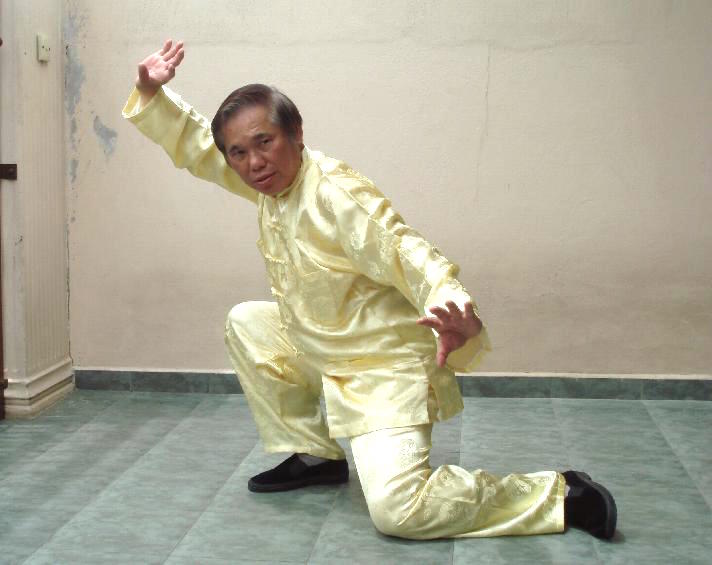
This pattern known as “Catch Tiger in the Mountain” is found in the shorter Tiger-Crane Set of Uncle Righteousness but not in the longer version of Sifu Lam Sai Weng
Question 5
Sifu Wong, you have mentioned before about using abdominal breathing to tap cosmic energy and store it in the dan tian. But is it possible to store 'too much' and become sick?
Answer
The answer to whether one can store too much cosmic energy in his dan tian and become sick, is yes and no. If he practices correctly, the answer is no. The dan tian is not a physical container; it is a field of energy. When there is more and more energy, the field becomes bigger and bigger.
Will the field explode? No, because there is no physical boundary. The field ends where the concentration of energy ends. What will happen when there is a lot of energy? There are two possibilities.
The energy overflows the field into the lower part of the “ren” or “conceptual” meridian from the dan tian to the “hui-yin” vital point near the anus. From there it crosses over the lower gap at the anus to meet the “du” or “governing meridian”.
As more energy accumulates, it flows up the “du meridian” along the spine, round the head and down to the upper lip. It crosses the upper gap at the mouth and meets the “ren” or “conceptual meridian” at the lower lip. Then it flows down the “ren meridian” along the front of the body back to the dan tian, completing the “Small Universe”.
When even more energy is added, the energy overflows from the “ren” and “du” meridians to all the twelve primary meridians, resulting in what we called the medical Big Universe.
In another development, as more energy is constantly added, the dan tian keeps expanding until its energy permeates the whole body. In other words the whole body is the dan tian. When more energy is added, the energy “breaks through” the physical body and merges with the Cosmos in what we called the spiritual Big Universe.
On the other hand, if a practitioner practices wrongly, too much energy at his dan tian can make him very sick.
Question 6
Someone mentioned to me a guy who practiced at a local kung fu school and he practiced too much chi kung and then went crazy. Is there a cure for it?
Answer
He has practiced wrongly. It is easy to practice advanced chi kung like Abdominal Breathing wrongly.
Yes, there are different ways to cure the illness. One way is to employ spontaneous chi flow. Another way is to have a master opens some of his vital points and channel the locked energy away.
Massage therapy, taking herbs and acupuncture can also overcome the problem.
Needless to say, any of these remedies must be performed by a qualified person. If he tries self healing, he is likely to aggravate his problem.
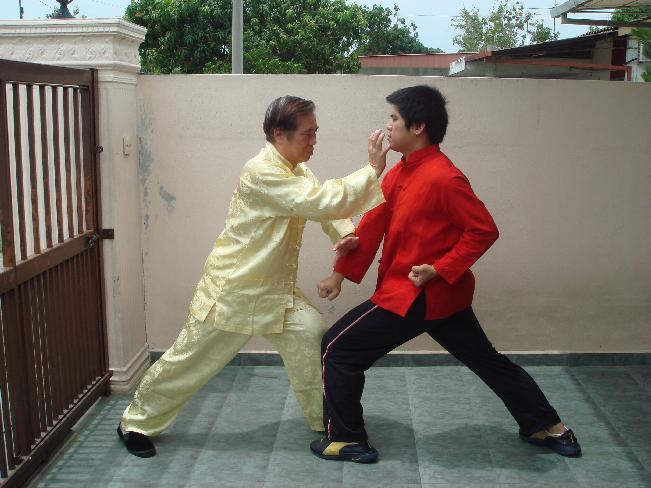
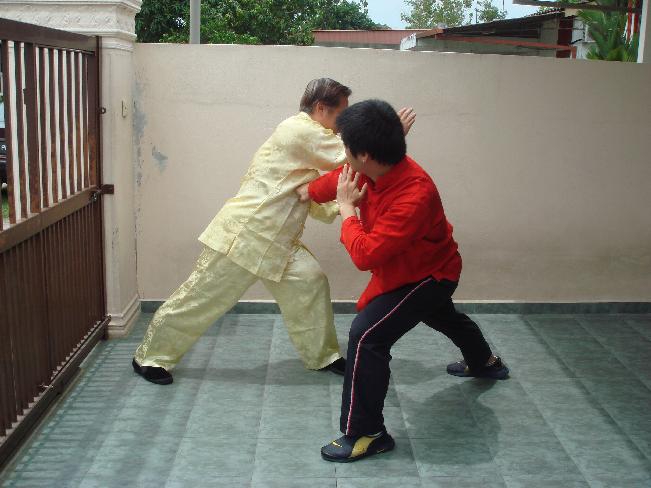
Grandmaster Wong attacks Sifu Wong Chun Nga with “Hungry Tiger Snatches Goat”. Sifu Wong Chun Nga brushes away the attack as he moves diagonally aside, and counters with a pattern from the Taming-Tiger Set, namely “Slant Body Strike Tiger”, striking Grandmaster Wong's ribs.
Question 7
Spontaneous chi flow is seen by some teachers as an advanced practice. However it is available more generally to practitioners through a number of "introductory" books, including your own.
— Ruth, UK
Answer
In our school, spontaneous chi flow is not an advanced exercise. It is basic. It means that every one of our students will experience spontaneous chi flow, usually at the beginning of their learning from us, often on the very first day.
However, spontaneous chi flow is rarely found in most other schools. If it is found, it is usually exclusive to advanced practitioners. Thus, many schools and teachers regard spontaneous chi flow as an advanced practice.
Yes, spontaneous chi flow is very beneficial. If you experience spontaneous chi flow regularly in your chi kung practice, your chi flow will become harmonious, which means you will have good health. When you continue your training, your harmonious chi flow will become vigorous, which means you will have vitality. When you continue your training further, you will have more chi than is needed for your use. The excess chi is stored at your dan tian as well as your eight wondrous meridians, giving you a plentiful supply of chi, which means you will have longevity.
This is simple and profound. It shows that if one wishes to have good health, vitality and longevity, he practices chi kung regularly to ensure spontaneous chi flow.
Actually all chi kung promotes spontaneous chi flow, including low-level chi kung. Low-level chi kung takes a long time, in terms of months or years, to produce a little spontaneous chi flow. Due to the long time and little amount, the result is often insufficient for overcoming illness or producing remarkable force. On the other hand, high-level chi kung takes a short time, in terms of days or weeks, to produce a lot of spontaneous chi flow. It is excellent for promoting health, vitality and longevity as well as internal force for marital art and spiritual cultivation.
Question 8
Material on the Shaolin Wahnam website makes it clear that having personally undertaken your courses does not allow one to teach this technique. However, I know how deeply beneficial it has been to me. My respect for you who gave me this technique and my memory of your words have led me to ask your permission to offer this to students when I feel the timing is appropriate. I would feel uncomfortable proceeding otherwise — which would be absolutely counterproductive! I am a certified reki master and chi kung teacher of another style.
Answer
While your intention to help others is noble, you should resist the temptation unless you have been well trained. Teaching spontaneous chi flow in our school may not be the same as teaching other arts in other styles.
The skill to generate spontaneous chi flow yourself is different from the skill to help others generate it. In other words, having benefited from spontaneous chi flow does not make you competent in teaching others to generate spontaneous chi flow, just us having recovered from an illness by taking medication does not make one competent to prescribe the same medication to others suffering from the same illness.
Please remember that spontaneous chi flow deals with life. If you teach others incorrectly — and you are likely to do so as you have not been properly trained — you would cause faulty chi flow which will affect their life.
LINKS
Selected Reading
- Technical Advantages of Shaolin Kungfu
- Tantui against Boxing and Kick-Boxing
- Chinese Martial Arts and Spiritual Cultivation
- Stance Training and Mental Clarity
- Important Questions regarding Practice after Intensive Chi Kung Course
